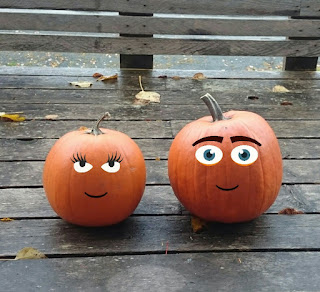In Haines, large carving pumpkins range from $10-$20. From what I can remember growing up in Connecticut, this isn't too much different from other places in the country. Because we're spending $20-$40 on pumpkins (from the produce section, mind you), wouldn't it make sense to use them for more than decoration?
 |
| My pumpkin and Kyle's pumpkin - TBC (to be carved) |
Toasting pumpkin seeds with sea salt has been a staple in my family since I can remember. They're delicious - and often gone before Halloween hits.
A couple of years ago, my husband, my best friend, and I decided to try a go at using what we could from the inside of the pumpkin.
After scraping away at the stringy bits that held the seeds in (and discarding it), we scraped further into the flesh of the pumpkin and put it to the side for cooking. We left about 1/2 inch of the pumpkin wall intact.
While scraping out much of the inside made the pumpkins easier to carve, the thinner walls did make for a more fragile decorating surface. Once we tasted the from-scratch pumpkin bars, it was completely worth it.
Most online recipes say that you need to actually cut the entire pumpkin into slices, cook them, and then scoop the flesh out. Why would we do that? We wanted to carve the pumpkin. So we scraped and scraped and scraped out the innards, and then baked what we had. After baking, it had to be pureed and then patted dry (to remove excessive water).
Pumpkin pastries (pies, cookies, bars, candy) are not the only option. Pureed pumpkin also makes a great soup base. If enough water is extracted from the pulp, it can even make a fun side dish in place of mashed potatoes. This post from One Green Planet outlines 10 ways to use pureed pumpkin.
Why am I so interested in eating the inside of these carving pumpkins, anyways? Aren't there baking pumpkins better for eating? Yes - there are. But I hear so many people in the clean plate club say "waste not, want not" - why waste when you can preserve for later use?
"True foodies" will gawk here - but to me, the satisfaction of using perfectly good food makes up for the (unnoticeable) difference in taste.
I have found that when extracted, cooked, pureed, and patted dry, two pumpkins will yield enough pumpkin puree to use for multiple purposes. If you don't feel like using the pumpkin that night (because carving pumpkins can actually be exhausting), freeze or jar the processed goodies for a surprise later.
Check out the nutrition behind pureed pumpkin (courtesy of SELF Nutrition Data)
Per 1/2 cup pureed pumpkin (canned):
Protein - 1.4 g
Fiber - 3.5 g (recommended for men=38 grams/day, for women=25 grams/day)
Vitamin A - 19000 IU (recommended daily allowance for men=3000 IU, for women=2300 IU)
Vitamin K - 20 IU (recommended daily allowance for men=80 IU, for women=65 IU)
Iron - 1.7 mcg (recommended daily allowance for men=8 mcg, for women=18 mcg)
 |
| Pumpkins can pack a powerful eye-health punch with that huge amount of vitamin A, but these little ones are best left for decoration |
UPDATE:
 |
| End thickness of the pumpkin wall - still strong enough to support carving |
 |
| Baking the pumpkin innards to soften them up for pureeing |
 |
| Pureed pumpkin (after it was cooked) and raw pumpkin seeds |
 |
| Final results - 2.5 mason jars full of pumpkin puree (in the fridge, because we didn't bother with a proper canning procedure) |
 |
| Happy Halloween! |
No comments:
Post a Comment